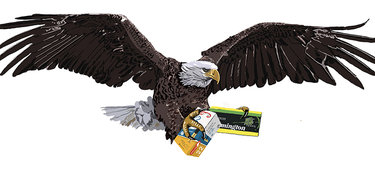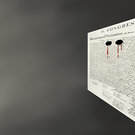By allowing the eagle to soar, we’ll be saving wildlife as well as ourselves
The only eagle indigenous to North America, the bald eagle became the symbol of the United States in 1782, when the Second Continental Congress approved a design for our national seal centered with the eagle.
The bald eagle holds a banner with the motto E Pluribus Unum — Out of Many, One — in its beak, a sheaf of arrows in one talon, and an olive branch in the other.
The eagle has been lauded as a symbol of courage and freedom.
In recent years, we have seen the bald eagle as something else: a symbol of resilience and of humankind’s abilities to right its wrongs.
Sixty years ago, our national symbol was in danger of extinction, largely because of DDT. The pesticide, widely adopted after World War II, washed into waterways poisoning fish and, in turn, the eagle.
The eagles produced eggs with thin shells that cracked during incubation or otherwise failed to hatch. By 1960, only about 400 breeding pairs remained; the bald eagle was on the verge of extinction.
Rachel Carson published “Silent Spring” in 1962, raising awareness of humans polluting the environment.
A decade later, the Environmental Protection Agency banned DDT. Slowly but surely, the population rebounded, topping 70,000 nesting pairs in the 21st Century.
But now we’ve been made aware the eagle faces a new threat. As we wrote earlier this month, eagles can ingest lead bullet fragments when scavenging the remains left behind after a hunter field dresses a deer.
The Department of Environmental Conservation’s Wildlife Health Program has measured lead levels in furbearers and other scavenging wildlife and found 44 percent of sampled fishers and 15 percent bobcats analyzed had detectable lead levels.
A study, “Vulnerability to lead toxicosis and bioindicatorutility of deer scavengers in New York,” written by DEC and Cornell Wildlife Health Lab biologists, was published in June in The Journal of Wildlife Management.
The authors note that lead is a heavy metal with no clear biological benefit, which is toxic to wildlife and humans alike. Although lead has been banned from several consumer products, it is not regulated in ammunition for big-game hunting in New York.
The scientists surveyed both avian and mammalian scavengers of deer remains in New York — including crows, owls, jays, hawks, doves, vultures, bears, squirrels, bobcats, racoons, coyotes, fishers, foxes, weasels, and skunks — and found that bald eagles and golden eagles are most vulnerable to lead poisoning and can serve as sort of a canary in the coal mine.
The DEC had published a report in 2022, “Minimizing Risks to Wildlife and People from Lead Hunting Ammunition,” which states, “The damaging effects of lead exposure to humans and wildlife are well studied.”
The report notes lead fragments left behind after a big-game animal is shot can remain in the meat, carcass, and within the gut pile, exposing people and scavenging wildlife to lead through consumption.
Health risks abound for both animals and humans.
Hunters are exposed to lead through firing lead ammunition and associated lead dust, the report says, noting lead fragments may remain in an animal carcass even after a processor removes visibly impacted meat from the wound channel.
Lead particles have been found 18 to 24 inches from the wound site in the carcasses of deer shot with lead bullets, exposing not just hunters but their families and others who share game meat, and those who may receive donations of game meat through food pantries.
The Food and Drug Administration does not recognize any safe limit for lead in game meat.
So why not just do what the EPA did with DDT, legislate to ban lead ammunition? Although the DDT ban was controversial in the 1970s, it has since been widely accepted and even lauded.
“Such a ban would be challenging to advance and based on research conducted by the Working Group would come with significant social costs, potentially compromising the effectiveness of other conservation efforts,” says the DEC report.
The Working Group is composed of staff from state’s departments of health and environmental conservation, Cornell University’s Wildlife Health Program, the Venison Donation Coalition, the New York State Conservation Council, and Audubon New York.
The group surveyed hunters and found most had never used non-lead ammunition, and half of hunters are not at all or only slightly concerned about the potential impacts to wildlife.
So the drive is on to educate hunters and also to expand state-wide a study on how increased use of non-lead ammunition for deer hunting can improve the survival of bald and golden eagles.
To that end, hunters across New York are now eligible for a rebate up to $60 for the purchase of non-lead ammunition for use during the 2024-25 deer hunting seasons.
As deer season approaches, we urge the hunters reading this to take advantage of the rebate and purchase non-lead ammunition.
Not only will you be saving money, you’ll be saving wildlife and the health of your family or friends who eat the game you bring home.
As the DEC study notes, once you are exposed, lead accumulates in your body over a lifetime. For adults, very low levels of lead exposure decrease cognitive function, increase neurological and joint pain, reduce sperm count, increase chances of miscarriage, harm fetal development, decrease kidney function, and raise blood pressure and chances of heart attack or stroke.
For children, even low levels of lead in blood can affect their health including reduced growth indicators; delayed puberty; lowered IQ; and hyperactivity, attention, behavior, and learning problems, according to the state’s health department and the Centers for Disease Control and Prevention.
A video produced by the DEC to encourage hunters to switch to non-lead bullets features Gordon Batcheller, the retired chief biologist for New York state, and a hunter for half a century.
He says, until a decade ago, he used the bullets that were available and affordable: lead-core, copper-jacketed bullets, but now, even if he has to order ahead, he uses copper ammo with a plastic tip that shoots with consistency.
Krysten Schuler, a wildlife disease ecologist at Cornell who was one of the authors of the paper establishing the eagle as a canary in the coal mine, also appears in the DEC video.
Her statements are direct and pithy: “Lead is a toxin, and it’s toxic in any dose,” she says. “There are no organisms that are safe from lead. It is a universal toxin. There is no safe dose of lead.”
We know that change is hard — but sometimes it is necessary.
We remember, years ago, talking to the late Steve Browne of Knox about his work at the DEC as a waterfowl specialist.
When Browne died in 2012, his successor, Bryan Swift, described him as “a combination of scientist and diplomat.”
One of the sweeping changes Browne brought about was controversial — the transition from lead shot to steel pellets for hunting waterfowl. The traditional lead shot was poisoning ducks that would pick through the mud and use the shot for grit for their digestion. Steel pellets had been developed in the 1970s but were unpopular with hunters; they had to learn to shoot differently.
Similarly, non-lead ammunition for deer hunting got a bad reputation in the 1980s for being high-priced and inaccurate, having a tendency to foul the barrel. But, since then, manufacturers undertook extensive research and development, solving many of the problems with inaccuracy and dropping the price of non-lead ammunition.
Barnes, Hornady, Winchester, and Remington all make non-lead bullets that cost the same as high-quality lead bullets.
“The mortality factor wasn’t obvious,” said Swift of the ducks poisoned by lead, and many hunters were set in their ways, not wanting to learn new techniques.
“Steve had to lead the educational campaign to inform hunters and get them to switch. There was a lot of resistance,” recalled Swift. “He took it to the masses, and was very involved in building grassroots acceptance. Ultimately, in 1988, it was made mandatory. But it took a toll on him.” Three years later, the ban was adopted nationwide.
“He was a very intense man,” said Swift. “He had a strong passion for what he believed in.”
We know hunters who are passionate about their sport, and we urge them to perpetuate the legacy they so love by switching to non-lead bullets. The switch will preserve the wildlife they value as well as their own health.
We believe, just as it took time to enact regulations to prevent the harm that comes from lead in paint or lead in water, it will take time to raise awareness about the importance of protecting public health from the lead in ammunition. But, the harder we push, the sooner we will all be safer.
Let’s remember the eagle, our symbol of courage and resilience. By helping the eagle to flourish, we’ll be helping ourselves.



Bravo, thank you Altamont Enterprise for this important article. What a way to honor Rachel Carson, eliminate lead in ammunition. May her hard work be remembered and carried forward together. We can all do our part to try to decrease the mess we’ve made of the environment affecting all life and all species Make it happen! Soon it will be the norm. People will develop the skills they need and it will become every day to not have lead ammunition we can do this.